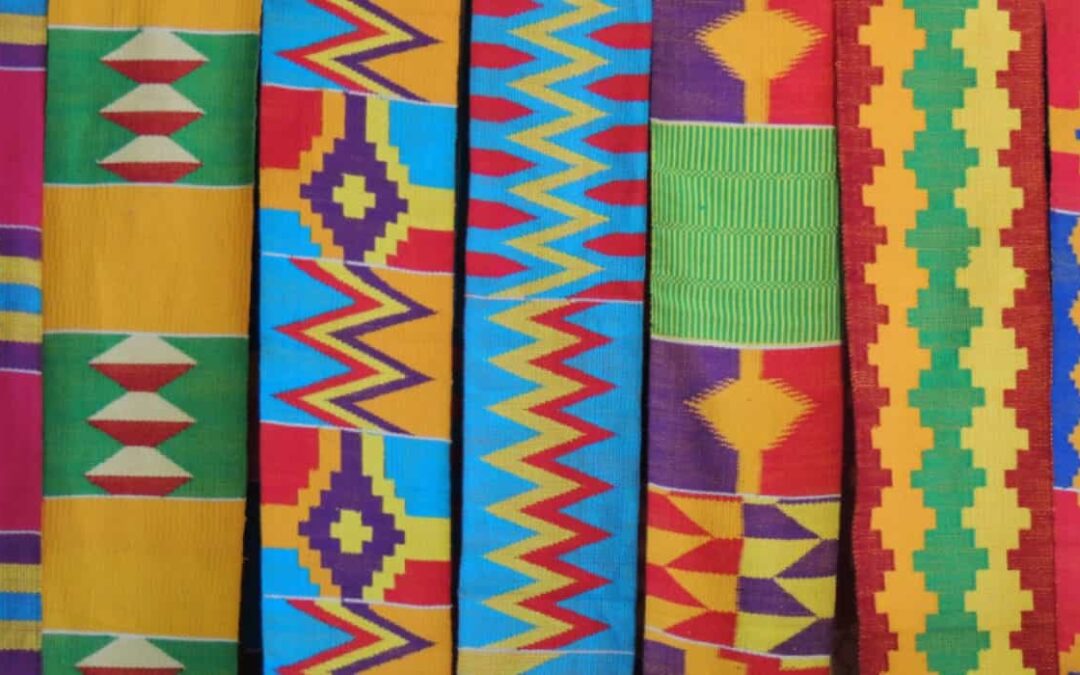Our founder, recently travelled to Ghana in West Africa. During his time there he visited several talented artisans including the kente weavers in the Ashanti Region.
Kente cloth originates from West Africa whereas African wax print fabric (commonly known as ‘Ankara’ in West Africa and ‘Kitenge’ in East Africa) was first produced in Indonesia.
HISTORY OF KENTE
Kente is no ordinary cloth and is easily recognisable worldwide. The method of producing kente, called strip weaving, has existed in West Africa since the 11th century. In 1697, the King of the Ashanti Kingdom, Osei Tutu, selected several weavers from nearby towns and villages to travel to neighbouring Ivory Coast to become experts in the complex art form.

Otumfuo Osei Tutu II, the current King of the Ashanti Kingdom wearing kente
Once they returned to Ghana, they started to weave the beautiful and colourful cloth exclusively for the King because kente was originally made and worn only by the royals. The weavers started to create their own unique designs, which are now well known worldwide as ‘Ashanti kente’. The Ewe is another ethnic group who also weave kente in Ghana.
Today, the Ashanti royals still wear the sacred cloth usually draped across the shoulders, including traditional black and white designs, for prestigious occasions including: ceremonies, worship, outings, marriages and funerals.

A weaver creating a traditional black and white kente design on a handloom in Ghana
MODERN AFRICAN PRINT CLOTHING
Today, the cloth can be purchased and worn by local people and kente outfits are very popular to wear at weddings and special occasions. Akans, from the Ashanti kingdom, traditionally wear clothes made from kente cloth. It is a source of pride for many Ghanaians and the Diaspora.
Original kente is a status symbol of wealth and identity as it is a luxurious and expensive fabric. Every new kente design is registered and copyrighted for protection. However, African wax print manufacturers in India, for example, are replicating the kente designs.
These fabrics are cheaper and more affordable than original kente cloth as they are printed by machine. This is likely to have contributed to the worldwide popularity of ‘kente’ as it is more readily available.
It has also encouraged young, aspiring fashion designers to experiment with the printed fabric by making modern African print clothing. As well as Ghanaian clothing fashion, kente is also used to make homewear such as blankets, pillowcases and place mats.
Raw Materials & Preparation
The type of raw materials used for weaving include:
- Cotton (grown in the north of Ghana)
- Silk (very expensive and was the traditional thread used)
- Rayon (synthetic fibre)
- Metallic thread (adds shine to cloth)
Usually, the threads are hand spun by villagers where the kente is made as it is cheaper than buying a ready spun cone. The traditional hand spinning method is demonstrated in this short video clip.
The dye used to change the thread colour can be made locally by grinding the bark or leaves of trees. Local dyes are preferred as the colours do not fade but most dyes are imported from China or Japan.

Different coloured threads and two shuttles used for weaving
METHOD OF WEAVING KENTE
Kente cloth is purely hand woven; no machinery is used. Weavers sit inside a wooden handloom to create long, narrow interwoven strips that are later sewn together by a tailor to make the traditional kente cloths.
It can take a long time to set-up a new design on a handloom, which requires a lot of experience. Weavers use both their hands and feet to operate the loom. The warp is placed quite far away from the loom under heavy stones to keep it taut, which gradually moves closer to the loom the more cloth that is produced.

The warp placed under heavy stones in front of the handloom

A weaver using their feet to control the handloom
The heddles (cords), separate the warp threads so the weft can be passed or thrown through using a shuttle. The warp is then beaten in evenly using the ‘beater’ to make it more compact.

A weaver using a shuttle to pass the weft through the warp
The more complicated the design the more expensive it is to purchase. There are 3 kinds of weaving known locally in this village as simple, double and triple. The latter being the most complicated as the designs can take 4-5 hours for an experienced weaver to make just one strip!
Or if you prefer you can draw your own design and they can replicate it for you. When President Obama visited they made a special design for him in his honor. If a local person does a good deed in their community they can also name a new design after them.

The finished kente cloth with all the strips joined together
Hidden Meanings
The kente cloth designs are powerful cultural symbols that represent history and philosophy. Each design has a specific name and significant meaning that reflects cultural values of Ghanaians as well as historical events. You can tell the symbolic meanings from the different designs and colours used.
Examples of meanings behind the designs:
1) Fatima Nkrumah
Kwame Nkrumah was the first President of Ghana after independence from Britain in 1957. The First Lady, Fatima Nkrumah, was Egyptian and he married her for unity. This design was named after her and symbolises the avoidance of racism and discrimination.
2) Zig-zag
Life is not a smooth journey; there may be many obstacles in the way.
3) Mako Maso Adeae (my heart’s desire)
Conveys the non-verbal message of ‘I love you’ to a lady by leaving it at her front door.
Other designs convey meanings of good health, wealth, strength etc.
Examples of meanings behind the colours:
Yellow – royalty, wealth, beauty
Green – fertility, vegetation, forest, new harvest
Red – blood of ancestors, political, death
Blue – peace, harmony, love
Pink – love, happiness
Orange – wealth, joy
Gold – royalty, wealth, high status
Silver – joy, purity
Black – heritage, strength, spirituality
White – purity, festive
Grey – healing
We hope you have enjoyed reading about kente.

